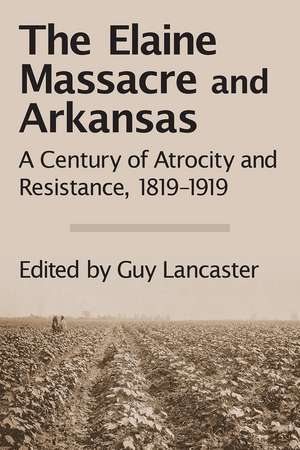The Elaine Massacre and Arkansas: A Century of Atrocity and Resistance, 1819-1919
Editat de Guy Lancasteren Limba Engleză Paperback – 31 mai 2018
Although it occurred nearly a century ago, the Elaine Massacre of 1919 remains the subject of intense inquiry as historians try to answer a multitude of questions, such as why authorities in the Arkansas Delta used such overwhelming violence to put down a farmers’ union, exactly how many people were killed in the massacre, and how the event shaped the following century.
We cannot fully understand what happened at Elaine without examining the one hundred years leading up to the massacre. An analysis of the years from 1819, when Arkansas officially became an American territory, to 1919 provides the historical foundation for understanding one of the bloodiest manifestations of racial violence in U.S. history.
During the antebellum years, slaveholders grew paranoid about possible “insurrections,” and after the Civil War and Emancipation, these fears lingered and led to numerous atrocities long before Elaine. At the same time, African Americans—particularly fieldworkers—worked to organize themselves to resist oppression, setting the stage for the farmers’ union that was the target for mob and military wrath during the Elaine Massacre.
These essays provide the larger history necessary for understanding what happened at Elaine in 1919—and thus provide a window into the current state of Arkansas and the nation at large. Contributors include Richard Buckelew, Nancy Snell Griffith, Matthew Hild, Adrienne Jones, Kelly Houston Jones, Cherisse Jones-Branch, Brian K. Mitchell, William H. Pruden III, and Steven Teske.
We cannot fully understand what happened at Elaine without examining the one hundred years leading up to the massacre. An analysis of the years from 1819, when Arkansas officially became an American territory, to 1919 provides the historical foundation for understanding one of the bloodiest manifestations of racial violence in U.S. history.
During the antebellum years, slaveholders grew paranoid about possible “insurrections,” and after the Civil War and Emancipation, these fears lingered and led to numerous atrocities long before Elaine. At the same time, African Americans—particularly fieldworkers—worked to organize themselves to resist oppression, setting the stage for the farmers’ union that was the target for mob and military wrath during the Elaine Massacre.
These essays provide the larger history necessary for understanding what happened at Elaine in 1919—and thus provide a window into the current state of Arkansas and the nation at large. Contributors include Richard Buckelew, Nancy Snell Griffith, Matthew Hild, Adrienne Jones, Kelly Houston Jones, Cherisse Jones-Branch, Brian K. Mitchell, William H. Pruden III, and Steven Teske.
Preț: 127.42 lei
Nou
Puncte Express: 191
Preț estimativ în valută:
24.38€ • 25.41$ • 20.19£
24.38€ • 25.41$ • 20.19£
Carte disponibilă
Livrare economică 13-27 martie
Preluare comenzi: 021 569.72.76
Specificații
ISBN-13: 9781945624070
ISBN-10: 1945624078
Pagini: 190
Dimensiuni: 152 x 229 x 20 mm
Greutate: 0.41 kg
Ediția:1
Editura: Butler Center for Arkansas Studies
Colecția Butler Center for Arkansas Studies
ISBN-10: 1945624078
Pagini: 190
Dimensiuni: 152 x 229 x 20 mm
Greutate: 0.41 kg
Ediția:1
Editura: Butler Center for Arkansas Studies
Colecția Butler Center for Arkansas Studies
Notă biografică
Guy Lancaster is the editor of the online Encyclopedia of Arkansas History & Culture, a project of the Butler Center for Arkansas Studies at the Central Arkansas Library System. He is the author of the award-winning Racial Cleansing in Arkansas, 1883–1924: Politics, Land, Labor, and Criminality and editor of Bullets and Fire: Lynching and Authority in Arkansas, 1840–1950.
